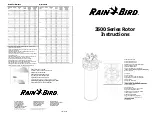
12
C L E A N I N G A N D D I S I N F E C T I O N
E N
5.2
Selection of the Cleaning and Disin-
fection Agents
The cleaning and disinfection agents must have
the following properties:
_
Cleaning agents
▪
General suitability for cleaning instruments
made of metal or plastic
▪
Compatibility with the components (see
section 8)
▪
When using an ultrasonic bath: Suitability of
the cleaning agent for ultrasonic cleaning (no
foaming)
_
Disinfection agents
▪
Tested efficiency (e.g. approval/authorisa-
tion/registration with/from VAH/DGHM or
FDA/EPA or CE marking)
▪
Compatible to the cleaning agent being used
5.3
Cleaning/Disinfection
▷
If possible: Disassemble components.
▷
Immerse the (disassembled) components com-
pletely in the cleaning/disinfection solution for
the duration of the specified immersion time.
▪
The components may not touch each other.
▪
No air may remain in cavities or hollow spaces.
▷
Thoroughly clean the components with a soft
brush and/or apply ultrasonic treatment for the
duration of the specified immersion time.
The brush may only be used for this purpose. Do
not clean with a metal brush or steel wool.
▷
Remove the components from the cleaning/dis-
infection solution and rinse intensively with
water at least three times (for at least one
minute).
Combined cleaning and disinfection
agents may only be used in the case of
exceptionally minor contamination (no vis-
ible contamination).
Cleaning and disinfection differ only by the
agents used, not by the procedure.
NOTE:
Insufficient results due to wrong agents or pro-
cedures!
▷
Observe the instructions of the manufacturers
of the cleaning and disinfection agents regard-
ing concentration, temperature, immersion
time and rinsing.
▷
Only use freshly prepared solutions.
▷
Only use sterile or slightly contaminated water
(e.g. purified/highly-purified water):
▪
max. 10 germs/ml
▪
max. 0.25 endotoxin units/ml
▷
For drying, use a soft, clean and lint-free cloth
and/or filtered air.













































